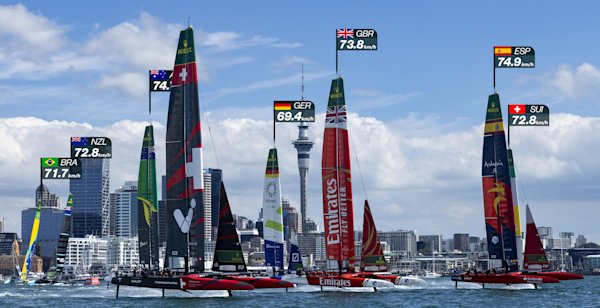Penalties are a key part of SailGP to ensure racing remains fair and equal for all teams. There are a number of rules which can be broken by the teams during racing, with penalties decided by the umpires following a protest by a competitor.
PENALTY POINTS
Tough rules are in place to discourage collisions on the race course. The umpiring team impose penalty points (which are dedicated from a boat’s event score) in the event of a collision.

Penalty points can be handed out to both the guilty boat on the water, but also the affected boat if the umpires agree it didn't do enough to avoid the collision.
Penalty points are determined utilizing the following methodology:
Collision
Boat responsible - four points
Boat involved - minimum two point (if it was possible for them to avoid)
Collision causing damage
Damage: Tech team needed to review and repair
Boat responsible - eight points
Boat involved - minimum four points (if it was possible for them to avoid)
Collision causing serious damage
Serious damage: Taken out of racing for the day
Boat responsible - 12 points
Boat involved - minimum six points (if it was possible for them to avoid)

Season Impact
At the end of an event, a team’s event point penalties result in the following deductions from its season championship score.
- 4 event points = two season points deducted
- 5-8 event points = four season points deducted
- 9-12 event points = eight season points deducted
- 13+ event points = 12 season points deducted

Dangerous driving: Black Flag
The umpires can give an immediate Black Flag disqualification to a team which puts another team at high risk of serious collision or capsize.

Race Start
Teams are penalized for starting races early, which is known as being on course side (OCS). This penalty is given when a boat crosses the start line before the gun and means the offending team has to drop behind the entire fleet.
Giving Way
A boat on port tack (a boat that has the wind coming from the left hand side) must give way to a boat on starboard tack (a boat with the wind coming from the right hand side).

Overlapping
When boats overlap while going in the same direction, the boat closest to the wind must keep out of the way. That boat is referred to as the windward boat. This means the boat furthest from the wind - the leeward boat - has the controlling position.
When boats are not overlapped and are sailing in the same direction, the boat behind must keep clear of the boat in front.

Boundary
The SailGP course is raced within a boundary, to keep the action tight. There is an 80m zone defined inside the entire course boundary, When two boats are inside that zone, the one closest to the boundary is allowed to sail the fastest route into and out of the zone.
Mark Roundings
Similarly to boundaries, marks have a circle zone around them 50m in diameter with the mark in its center. When boats overlap as they enter the mark zone, the boat on the inside must be given room to go around the mark. The boat on the outside must allow the inside boat to take the turn.
When boats are not overlapped, the boat which entered the zone first has the right to go around the mark. Teams will fight hard for the inside line, especially at the all-important first mark.

Right of Way
When a team with right of way makes a significant change in their direction, they need to give boats in close proximity time to react. Even with right of way, they must do everything they can to avoid a collision.


